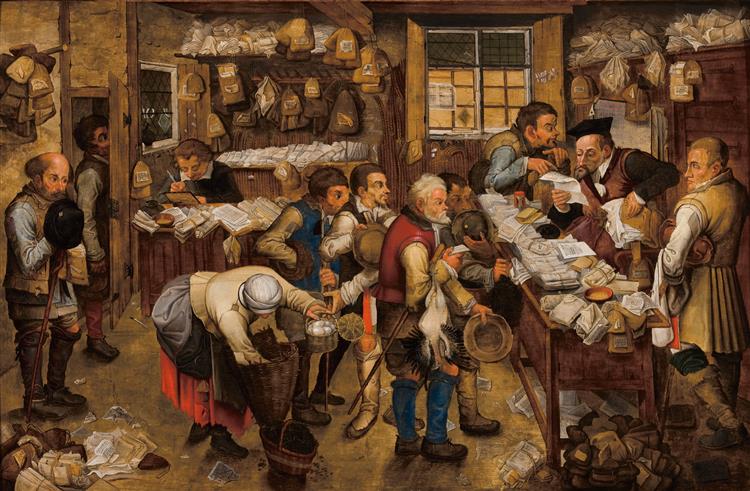Descrizione
The Tax Collector’s Office, painted in 1615 by Pieter Brueghel the Younger, is a work that encapsulates the social and economic concerns of its time, offering a snapshot of everyday life in 17th-century Europe. Part of a tradition of depicting genre scenes that prioritized keen observation of popular life, the work reflects the painter’s mastery of visual narrative and detail.
From the first glance, the painting's composition is notable for its dynamism and the way elements are arranged within the space. At the center of the work, a tax collector stands surrounded by a bustling group of people, each immersed in their own world, creating a vibrant snapshot of human interaction. Brueghel the Younger, known for his recreations of works by his father, Pieter Brueghel the Elder, was able to interpret and transform these formats into his own visions. Unlike his progenitor, who often focused on rural themes and allegories, Brueghel the Younger tends to incorporate a clear sense of social criticism throughout his works.
The colour palette used in this painting is rich and varied, with earthy and dark tones predominating, evoking an atmosphere of seriousness. The shades of brown, grey and green contribute to highlighting the harshness of the everyday life of the people portrayed. However, despite this sombre palette, there are light touches of colour that emerge here and there, providing a contrast that enlivens the scene and keeps the viewer's attention. It is a balanced representation of misery and everyday life, where economics and power mix in a space of human interaction.
The diversity of characters in the work is noteworthy. From the tax collector, who is presented as an authority figure, to the citizens facing the burden of the tax, each figure possesses a distinctive character. The variety of attire is also notable; the different styles of clothing suggest both the social class and the mood of those portrayed. The older man who seems to express resignation to the situation reveals an undercurrent of suffering that resonates with many of the artist’s contemporaries, while the woman beside the tax collector demonstrates an arguably more intimate concern, reflecting the nervousness and tension surrounding the act of paying taxes.
Interestingly, this type of work fits into a larger trend in 17th-century painting towards the exploration of social and economic themes, reflecting the tensions that arose in an age of increasing modernisation and mercantilism. Tax-paying scenes in particular have been addressed in the works of a number of artists, but Brueghel the Younger's ability to communicate human empathy and social criticism through an almost cartoonish and lively treatment sets him apart.
The Tax Collector’s Office is not only a reminder of art’s diligence in observing everyday life, but also a meditation on power and authority, and how these forces affect ordinary individuals. Brueghel’s ability to capture a range of human emotions and responses in a single frame makes this work an enduring testament to his artistic genius. Ultimately, the painting opens a dialogue about humanity, struggle, and everyday life, evidencing art’s role as a critical mirror of society.
KUADROS ©, a famous painting on your wall.
Hand-made oil painting reproductions, with the quality of professional artists and the distinctive seal of KUADROS ©.
Painting reproduction service with satisfaction guarantee. If you are not completely satisfied with the replica of your painting, we will refund 100% of your money.

